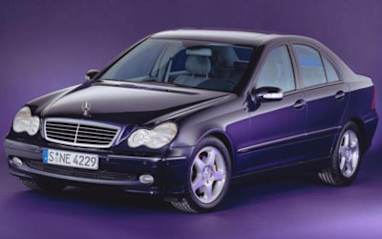Used Mercedes-Benz C180 review: 1994-2001
By Graham Smith · 28 Jan 2009
The was something off-putting about the 180E Mercedes produced before the C-Class was launched in 1994. It had the star on the bonnet, but the rest of the 180E just didn’t seem to make the Mercedes grade. Thankfully Mercedes corrected the situation with the C-Class.The 180E was clearly a car for the masses, even if the asking price meant the masses had to be quite well-heeled to have any chance of getting behind the wheel. But there was something about it that suggested Mercedes had cut a few too many corners to get the price down as far as it did.Anyone accustomed to the level of equipment that usually came with the three-pointed star would have been shocked to find that it had wind up windows, vinyl seats, and a seriously underpowered engine.The C-Class was a different story. It was an important new model in the new generation of ’Benz cars, one that delivered the traditional Mercedes quality in a much more affordable package without the compromises of its predecessor. If the 180E left you feeling like a ‘wannabe’ Benz owner, the C-Class made you feel like a paid-up member of the club.MODEL WATCHThe C-Class had to overcome some built up resistance when it first came out, such was the poor reputation the 180E won, but anyone who wrote off the new car failed to see a totally new car with the old Mercedes’ attributes.Build quality was high, as you would expect of a car costing almost $60,000 and more in 1994, performance was much improved, and there was enough fruit to satisfy most ’Benz owners.When Mercedes launched the 180E in 1991 it was looking to expand its owner base in order to survive in the long term. The company simply couldn’t survive on a diet of high priced luxury cars, there just wasn’t enough buyers able to afford the ’Benz asking prices.The company was under attack on many fronts. BMW was giving it some curry, particularly with the 3 and 5 Series, and the Japanese companies like Toyota were causing Benz plenty of heartache with its Lexus, which was taking sales away from the S-Class.The 180E was an attempt to compete with the BMW 3-Series, but Mercedes made the fatal mistake of pricing it well above the small Beemer in the belief that people would line up for a car carrying the three-pointed star even if it didn’t deliver anything more than its cheaper rival.They didn’t, which meant Mercedes had some catching up to do with the C-Class. Thankfully they came closer to the mark the second time around.Although there was nothing particularly striking about the C-Class styling, it was actually quite conservative, it has stood the test of time well and still looks current and classy a decade after it was launched.A compact sedan, the C-Class offers comfortable seating for four. There is accommodation for five, but it has to be said that three across the back seat would be a little uncomfortable.Power for the C-180 entry level model came courtesy of a 1.8-litre double overhead camshaft, four valve, fuel injected four-cylinder engine that put out 90 kW at 5500 revs and 170 Nm at 4200 revs.When the right pedal was pressed deep into the carpet it would reach 100 km/h in around 12 seconds, while racing through the standing 400-metre sprint in a little over 18 seconds.They’re reasonable times, but achieved through relatively short gearing and top end power. As a result the mid-range is a little lacking so it feels a little lethargic when not pushed hard.The standard transmission was a five-speed manual with floor shift, but most were delivered with the optional four-speed, or later, five-speed automatic.Underneath, the C-Class boasted double wishbone front suspension along with a multilink independent rear suspension. Isolation from bumps and potholes in the road was superb, and it didn’t come at the expense of handling, which was well balanced and precise.Add to that four wheel disc brakes, with ABS, and power steering which was well weighted and nice road feel, and the C-Class was a pleasure to drive.At launch Mercedes offered two levels of trim, the base Classic and the better equipped Elegance. The Classic had cloth trim, air-conditioning, central locking, power front windows, power mirrors, rear head rests, and an airbag for the driver. From November 1997 it also had cruise, a passenger airbag, and a five-speed auto in place of the four-speed.The Elegance added dual airbags, CD player, leather steering wheel, wood trim, rear seat pockets and power rear windows. The Elegance was replaced by the C200 Elegance in 1997.From November 1994 there was also a sporty Esprit model with bright coloured seat inserts and lowered suspension. Like the Elegance, the C-180 Esprit was replaced by the C200 model.IN THE SHOPMechanics report few problems with the C-180. It’s generally regarded as robust and reliable.The only problem of note mentioned is the heater fan on cars after 1996. Because it’s run all the time it can burn out, and replacements are around $800.Other than that there are reports of some failures of the air mass meter on cars that have covered 150,000 to 200,000 km. That’ll set you back $2500 for a factory replacement, $1500 for a rebuilt one.Look for a service record from a Mercedes dealer or recognised specialist service agent, and inspect closely for signs of crash damage, like colour mismatches, poor panel fit, and variable body gaps.LOOK FOR• prestige of three-pointed star badge• high build quality• solid body with few squeaks and rattles• sure-footed handling• comfortable ride• four cylinder engine in heavy body means modest performanceVERDICTWell built, well equipped, and very competent compact sedan with all the prestige of the ’Benz brand, but comes at a price.RATING70/100










